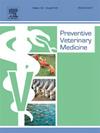与小牛肉生产中抗菌剂使用水平相关的关键农场特征——丹麦数据库研究。
IF 2.2
2区 农林科学
Q1 VETERINARY SCIENCES
引用次数: 0
摘要
与其他牛生产类型相比,小牛肉生产中的抗菌素使用(AMU)很高,已被认为是一个有可能减少AMU的领域。高AMU是一个公共卫生问题,因为它与抗菌素耐药性(AMR)有关。确定与AMU相关的农场特征可以为寻求监测和实施减少AMU举措的利益相关者提供有价值的见解。本研究旨在调查丹麦小牛肉农场与AMU相关的农场特征,这是丹麦主要的小牛肉生产类型。AMU及其特征从两个丹麦国家数据库中提取;丹麦中央畜牧登记(CHR)和丹麦兽医统计计划(VetStat)。特征包括农场规模、死亡率、供应商数量、每个农场的地点以及动物在性别和品种方面的农场水平组成。研究中包括的118个农场在2020年接受了以动物日剂量(ADD)计算的丹麦犊牛和幼畜抗菌素处方总量的41% %。建立了以年平均农场水平AMU为结果的多变量线性回归模型。AMU以每100只动物每天的ADD (ADD100)来测量,并在模型中进行平方根变换。增加农场规模和供应商数量以及减少杂交公牛比例与较高的AMU显著相关。而杂交公牛的比例与雌性的比例呈正相关。将品种和性别的影响分开是不可能的,部分原因是高度汇总的数据结构。死亡率和位点数量与AMU无显著相关。与其他类型的小牛肉农场相比,“发酵剂农场”类型的农场先前已被证明具有更高的AMU。本研究的一个重要发现是,通过使用所有权数据将多个地点分组为农场,可以总结从到达小牛肉农场到离开屠宰的整条生产线的AMU。本文的结果和方法为重复评估与AMU相关的农场特征提供了机会,这些特征可用于持续适应和定向AMU监测和控制。此外,它是在现有的监测数据上完成的,这使得研究在数据收集和数据管理方面的成本很低。本文章由计算机程序翻译,如有差异,请以英文原文为准。
Key farm characteristics associated with the level of antimicrobial use in rosé veal production – A Danish database study
Antimicrobial use (AMU) in veal production is high compared to other bovine production types and has been suggested as an area with potential for AMU reduction. High AMU is a public health concern due to its association with antimicrobial resistance (AMR). Identifying farm characteristics associated with AMU could provide valuable insights for stakeholders seeking to monitor and implement initiatives to reduce AMU. This study aimed at investigating farm characteristics associated with AMU in Danish rosé veal farms, which is the main veal production type in Denmark. The AMU and characteristics included were extracted from two Danish national databases; The Danish Central Husbandry Register (CHR) and the Danish Veterinary Medicines Statistics Program (VetStat). Characteristics included were farm size, mortality, number of suppliers, sites per farm, and farm-level composition of animals with regards to sex and breed. The 118 farms included in the study received 41 % of the total amount of antimicrobials prescribed for Danish calves and young stock in 2020 measured in Animal Daily Doses (ADD). A multivariable linear regression model with the annual average farm-level AMU as outcome was created. AMU was measured as ADD per 100 animals per day (ADD100) and square root-transformed in the model. Increasing farm size and number of suppliers and decreasing proportion of crossbred bulls were found to be significantly associated with higher AMU. However, proportion of crossbred bulls was correlated with proportion of females. Separating the effects of breed and sex was not possible, partly due to the highly summarised data structure. Mortality and number of sites were not significantly associated with AMU. Farms with the type “starter-farms” has previously been shown to have a higher AMU compared to other rosé veal farm types. An important finding in this study was that grouping multiple sites into farms by using ownership data made it possible to summarise AMU for the full line of production from arrival at the veal farm to exit for slaughter. The results and approaches from this paper present an opportunity for repeated evaluation of farm characteristics associated with AMU, which could be used to continuously adapt and target AMU monitoring and control. In addition, it is done on existing surveillance data which keeps the cost of the study low in terms of data collection and data management.
求助全文
通过发布文献求助,成功后即可免费获取论文全文。
去求助
来源期刊

Preventive veterinary medicine
农林科学-兽医学
CiteScore
5.60
自引率
7.70%
发文量
184
审稿时长
3 months
期刊介绍:
Preventive Veterinary Medicine is one of the leading international resources for scientific reports on animal health programs and preventive veterinary medicine. The journal follows the guidelines for standardizing and strengthening the reporting of biomedical research which are available from the CONSORT, MOOSE, PRISMA, REFLECT, STARD, and STROBE statements. The journal focuses on:
Epidemiology of health events relevant to domestic and wild animals;
Economic impacts of epidemic and endemic animal and zoonotic diseases;
Latest methods and approaches in veterinary epidemiology;
Disease and infection control or eradication measures;
The "One Health" concept and the relationships between veterinary medicine, human health, animal-production systems, and the environment;
Development of new techniques in surveillance systems and diagnosis;
Evaluation and control of diseases in animal populations.
 求助内容:
求助内容: 应助结果提醒方式:
应助结果提醒方式:


